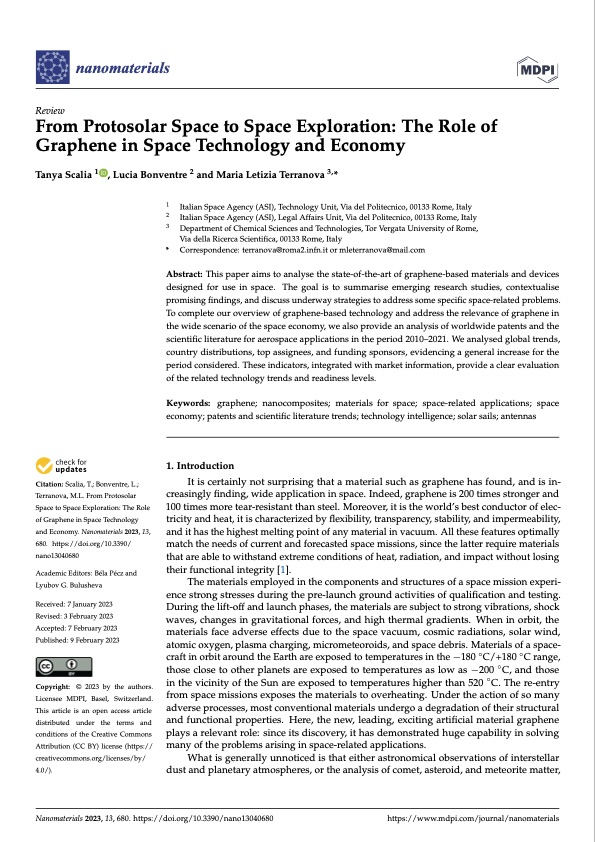
PDF Publication Title:
Text from PDF Page: 001
nanomaterials Review From Protosolar Space to Space Exploration: The Role of Graphene in Space Technology and Economy Tanya Scalia 1 , Lucia Bonventre 2 and Maria Letizia Terranova 3,* Citation: Scalia, T.; Bonventre, L.; Terranova, M.L. From Protosolar Space to Space Exploration: The Role of Graphene in Space Technology and Economy. Nanomaterials 2023, 13, 680. https://doi.org/10.3390/ nano13040680 Academic Editors: Béla Pécz and Lyubov G. Bulusheva Received: 7 January 2023 Revised: 3 February 2023 Accepted: 7 February 2023 Published: 9 February 2023 Copyright: © 2023 by the authors. Licensee MDPI, Basel, Switzerland. This article is an open access article distributed under the terms and conditions of the Creative Commons Attribution (CC BY) license (https:// creativecommons.org/licenses/by/ 4.0/). 1 2 3 * Correspondence: terranova@roma2.infn.it or mleterranova@mail.com Abstract: This paper aims to analyse the state-of-the-art of graphene-based materials and devices designed for use in space. The goal is to summarise emerging research studies, contextualise promising findings, and discuss underway strategies to address some specific space-related problems. To complete our overview of graphene-based technology and address the relevance of graphene in the wide scenario of the space economy, we also provide an analysis of worldwide patents and the scientific literature for aerospace applications in the period 2010–2021. We analysed global trends, country distributions, top assignees, and funding sponsors, evidencing a general increase for the period considered. These indicators, integrated with market information, provide a clear evaluation of the related technology trends and readiness levels. Keywords: graphene; nanocomposites; materials for space; space-related applications; space economy; patents and scientific literature trends; technology intelligence; solar sails; antennas 1. Introduction It is certainly not surprising that a material such as graphene has found, and is in- creasingly finding, wide application in space. Indeed, graphene is 200 times stronger and 100 times more tear-resistant than steel. Moreover, it is the world’s best conductor of elec- tricity and heat, it is characterized by flexibility, transparency, stability, and impermeability, and it has the highest melting point of any material in vacuum. All these features optimally match the needs of current and forecasted space missions, since the latter require materials that are able to withstand extreme conditions of heat, radiation, and impact without losing their functional integrity [1]. The materials employed in the components and structures of a space mission experi- ence strong stresses during the pre-launch ground activities of qualification and testing. During the lift-off and launch phases, the materials are subject to strong vibrations, shock waves, changes in gravitational forces, and high thermal gradients. When in orbit, the materials face adverse effects due to the space vacuum, cosmic radiations, solar wind, atomic oxygen, plasma charging, micrometeoroids, and space debris. Materials of a space- craft in orbit around the Earth are exposed to temperatures in the −180 ◦C/+180 ◦C range, those close to other planets are exposed to temperatures as low as −200 ◦C, and those in the vicinity of the Sun are exposed to temperatures higher than 520 ◦C. The re-entry from space missions exposes the materials to overheating. Under the action of so many adverse processes, most conventional materials undergo a degradation of their structural and functional properties. Here, the new, leading, exciting artificial material graphene plays a relevant role: since its discovery, it has demonstrated huge capability in solving many of the problems arising in space-related applications. What is generally unnoticed is that either astronomical observations of interstellar dust and planetary atmospheres, or the analysis of comet, asteroid, and meteorite matter, Italian Space Agency (ASI), Technology Unit, Via del Politecnico, 00133 Rome, Italy Italian Space Agency (ASI), Legal Affairs Unit, Via del Politecnico, 00133 Rome, Italy Department of Chemical Sciences and Technologies, Tor Vergata University of Rome, Via della Ricerca Scientifica, 00133 Rome, Italy Nanomaterials 2023, 13, 680. https://doi.org/10.3390/nano13040680 https://www.mdpi.com/journal/nanomaterialsPDF Image | Role of Graphene in Space Technology

PDF Search Title:
Role of Graphene in Space TechnologyOriginal File Name Searched:
nanomaterials-13-00680-v2.pdfDIY PDF Search: Google It | Yahoo | Bing
Salgenx Redox Flow Battery Technology: Power up your energy storage game with Salgenx Salt Water Battery. With its advanced technology, the flow battery provides reliable, scalable, and sustainable energy storage for utility-scale projects. Upgrade to a Salgenx flow battery today and take control of your energy future.
| CONTACT TEL: 608-238-6001 Email: greg@infinityturbine.com | RSS | AMP |